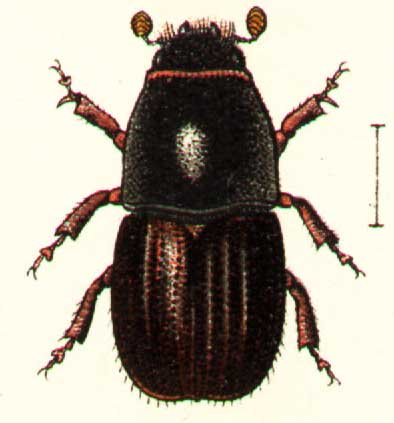
Superregnum: Eukaryota
Cladus: Unikonta
Cladus: Opisthokonta
Cladus: Holozoa
Regnum: Animalia
Subregnum: Eumetazoa
Cladus: Bilateria
Cladus: Nephrozoa
Cladus: Protostomia
Cladus: Ecdysozoa
Cladus: Panarthropoda
Phylum: Arthropoda
Subphylum: Hexapoda
Classis: Insecta
Cladus: Dicondylia
Subclassis: Pterygota
Cladus: Metapterygota
Infraclassis: Neoptera
Cladus: Eumetabola
Cladus: Endopterygota
Superordo: Coleopterida
Ordo: Coleoptera
Subordo: Polyphaga
Superfamilia: Curculionoidea
Familia: Curculionidae
Subfamilia: Scolytinae
Tribus: Scolytini
Subtribus: Scolytina
Genus: Scolytus
Species: Scolytus scolytus
Name
Scolytus scolytus (Fabricius, 1775)
References
Zoological Institute of Russian Academy of Sciences: Bark beetle Scolytus scolytus (Fabricius, 1775) - photo by D.I. Gavryushin
Scolytus scolytus, the larger European elm bark beetle or large elm bark beetle, is a 3.5–6 mm long bark beetle species.[4][5] It is of significant importance in Eurasia as a vector of Dutch elm disease.
Description
Pronotum black and shiny, with red-brown anterior and posterior margins. Elytra, antennae, legs and abdomen are red-brown. Forehead with fine wrinkles and tubercles and a thick brush of hairs. Female's forehead convex, male's is flattened. Elytra bear well developed but shallow longitudinal punctate grooves. Elytra are tapering posteriorly. Abdomen sharply concave, oblique to the tip. In the middle of the posterior edge of the third and fourth abdominal segments there is usually an acute tubercle. The males have a continuous (although incrementally shorter toward middle) brush of golden hair at the apex of the abdomen.[4][5]
Life cycle
The first generation flies mainly in June, in certain years stretching from the end of May to the middle of July. The second generation flies in August. Females prefers to lay their eggs under the bark of the lower part of the trunk, in areas where the cortex is thicker, most often on weakened standing trees or fallen trees. Egg galleries are longitudinal, 2–7 cm long, over 2 mm wide but no more than 3 mm. Larval galleries start perpendicularly from the egg gallery, the upper ones are bent upward, the lower ones downward, and the ones at the middle run rather parallelly from ones another. Larval galleries located on lower parts of the trunk are imprinted on the inner surface of the cortex, sometimes on the sapwood too to some extent. Pupal chambers are usually located in the bark. After emerging, adult beetles feed on the crotches of young twigs, and leaf petioles. Partly-developed to fully developed larvae overwinter. In the northern part of its range there is usually one generation per year, in the steppes 1 to 2 generations, and in the Caucasus usually 2 with possible indications of a third one.[4][5]
Distribution
This species has been reported from throughout Europe and western Asia. In Russia, approximately as far east as Irkutsk Oblast and as far north as the southern boundary of the taiga zone. In Asia, it has also been reported from Turkey, Armenia, Azerbaijan, Georgia, Kazakhstan, China, northern Iran, and northern India (Jammu and Kashmir). In Africa, it has been reported from Morocco and Algeria.[2][3][5][6]
Host plants
Reported host plants are primarily elms, but also, common ash, common walnut tree, Caucasian zelkova, as well as a number of trees in the genera Prunus (stone fruits), Quercus (oaks), Salix (willows), and Populus (for black poplar and aspen).[2][3][5]
References
Fabricius, Johann Christian (1775). Systema entomologiae: sistens insectorvm classes, ordines, genera, species, adiectis synonymis, locis, descriptionibvs, observationibvs (in Latin). p. 59.
"Scolytus scolytus (large elm bark beetle)". Invasive Species Compendium. CABI. Retrieved 18 March 2017.
Wood, S.L.; Bright, D.E. (1992). "A catalog of Scolytidae and Platypodidae (Coleoptera). Part 2: Taxonomic Index Volume A". Great Basin Naturalist Memoirs. 13: 371–376.
Старк, BH (1952). фауна СССР. Жесткокрылые. Tom 31. Короеды (PDF) (in Russian). Издательство академии наук СССР. pp. 109–111. [Stark, V.N. (1952). Fauna of the USSR. Coleoptera. Vol. 31. Bark-beetles. Academy of Sciences of the USSR.]
Ижевский, С.С.; Никитский, Н.Б.; Волков, О.Г.; Долгин, М.М. (2005). Иллюстрированный справочник. жуков-ксилофагов - вредителей леса и лесоматериалов Российской Федерации (PDF) (in Russian). Тула: Российская Академия Наук, Уральское отделение, Коми научный центр, Институт биологии. pp. 169–170. [Izhevsky, S.S.; et al. (2005). An illustrated guide to the xylophagous beetles injuring forests and timber in the Russian Federation. Tula: Russian Academy of Sciences, Ural Branch, Komi Science Center, Institute of Biology.]
"Large elm bark beetle". PaDIL. Retrieved 18 March 2017.
Retrieved from "http://en.wikipedia.org/"
All text is available under the terms of the GNU Free Documentation License

